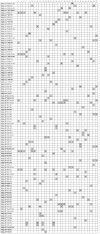MHC class I allele diversity in cynomolgus macaques of Vietnamese origin
- PMID: 31720104
- PMCID: PMC6836755
- DOI: 10.7717/peerj.7941
MHC class I allele diversity in cynomolgus macaques of Vietnamese origin
Abstract
Cynomolgus macaques (Macaca fascicularis, Mafa) have been used as important experimental animal models for carrying out biomedical researches. The results of biomedical experiments strongly depend on the immunogenetic background of animals, especially on the diversity of major histocompatibility complex (MHC) alleles. However, there is much less information available on the polymorphism of MHC class I genes in cynomolgus macaques, than is currently available for humans. In this study, we have identified 40 Mafa-A and 60 Mafa-B exons 2 and 3 sequences from 30 unrelated cynomolgus macaques of Vietnamese origin. Among these alleles, 28 are novel. As for the remaining 72 known alleles, 15 alleles are shared with other cynomolgus macaque populations and 32 are identical to alleles previously reported in other macaque species. A potential recombination event was observed between Mafa-A1*091:02 and Mafa-A1*057:01. In addition, the Mafa-A1 genes were found to be more diverse than human HLA-A and the functional residues for peptide binding sites (PBS) or TCR binding sites (TBS) in Mafa-A1 have greater variability than that for non-PBS or non-TBS regions. Overall, this study provides important information on the diversity of Mafa-A and Mafa-B alleles from Vietnamese origin, which may help researchers to choose the most appropriate animals for their studies.
Keywords: Cynomolgus macaque; Diversity; Major histocompatibility complex.
©2019 Huang et al.
Conflict of interest statement
The authors declare there are no competing interests.
Figures




References
-
- Allen TM, Sidney J, Del Guercio MF, Glickman RL, Lensmeyer GL, Wiebe DA, DeMars R, Pauza CD, Johnson RP, Sette A, Watkins DI. Characterization of the peptide binding motif of a rhesus MHC class I molecule (Mamu-A*01) that binds an immunodominant CTL epitope from simian immunodeficiency virus. Journal of Immunology. 1998;160(12):6062–6071. - PubMed
-
- Bakker NP, Erck MG, Van Otting N, Lardy NM, Noort RC, t Hart BA, Jonker M, Bontrop RE. Resistance to collagen-induced arthritis in a nonhuman primate species maps to the major histocompatibility complex class I region. Journal of Experimental Medicine. 1992;175(4):933–937. doi: 10.1084/jem.175.4.933. - DOI - PMC - PubMed
LinkOut - more resources
Full Text Sources
Research Materials

